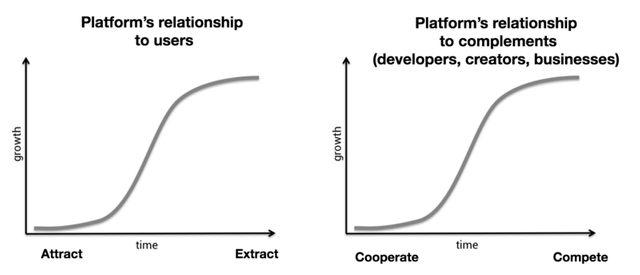The Rise of Internet 3.0 Will Lead to the Disaggregation of User Data
Tony Sheng’s thesis is the rise of Internet 3.0 will result in the demise of state aggregators like Facebook. Because blockchains can capture user data at the protocol level, creating an opportunity for decentralized competitors. This summary is intended to provide an understanding of his thesis outlined in Disaggregation Theory and Internet 3.0 and the demise of state aggregators without needing to read these source material in their entirety.
The decentralized internet is an exciting promise that has yet to see mainstream adoption of many use cases. Is it possible that the natural state of the internet is centralization? If not, what can shift the balance from centralized to decentralized?
Why did the internet centralize. Open protocols like HTTP allowed everybody to use them as a foundation for their applications because they could trust they wouldn’t change. However, there was a problem: open protocols did not capture state (user data). So if I clicked a button on your site, you had no way of remembering my action the next time I visited.
Leading to the invention of cookies. Cookies started out as a way to record user visits to sites. Then companies started using cookies to aggregate user data leading to the dominant entities we see today.
Using cookies to aggregate supply allowed companies to focus on owning discovery via their user data. Once owned, this user data led to the creation of distinctive user experiences competitors could not replicate.
By owning the customer relationship, these companies could serve the same customers with an expanding set of goods and services. Consider Amazon: a company that started off selling books now winning Emmys and providing cloud services for the world’s largest companies.
Consumer backlash against these entities has begun because there is a fundamental misalignment of incentives between them and their users.
The charts below illustrate this misalignment.

Enter blockchain based protocols like Ethereum that can store user data

Apps relying on user data can now be built out on top of decentralized protocols. Instead of relying on the current dominant centralized platforms that control most of our web-based activities today.
- In Internet 2.0, supply is high value because any good-will experienced by the consumer will be directed to the content creators (not the publisher).
- In Internet 3.0, supply should remain high value. Potentially favorable alternative monetization opportunities could emerge through blockchain.
- In Internet 2.0, discovery is worth a lot and owned by very few players.
- In Internet 3.0, discovery will continue to be high value. The competitive moats Internet 2.0 companies currently enjoy will weaken, lowering the barriers to entry and enabling a more competitive environment.
In the short run, the UX offered by these new entrants will pale in comparison to those built by Internet 2.0 companies for two reasons: less user data and the handicaps of blockchain technology. Overall, the UX of the decentralized web will feel a lot less magical.
Giving users a choice between the superior UX of today’s internet companies and the superior privacy and data sovereignty of decentralized competitors. Long term, the gap should narrow, but the ability of decentralized apps to provide the same kinds of experiences as centralized competitors may never completely close.
Cautious optimism is warranted. The ecosystem continues to evolve attracting the talent needed to deliver the ongoing technical and user experience improvements needed for widespread adoption to occur.
Thanks for Reading
Join the MPower365 newsletter to stay up to date on my latest research into cryptoasset investments!
Questions, suggestions for improvements. Please reach out.
good job